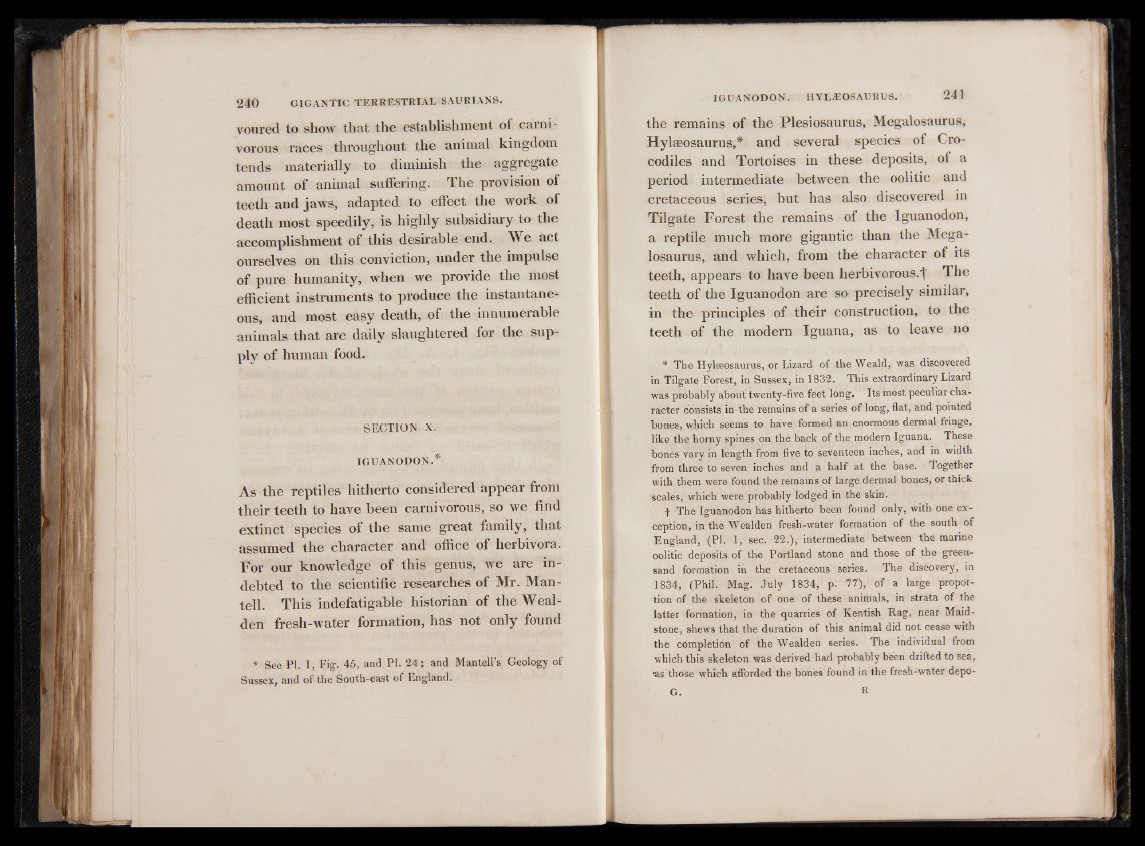
voured to show that the establishment of carnivorous
races throughout the animal kingdom
tends materially to diminish the aggregate
amount of animal suffering. The provision of
teeth and jaws, adapted to effect the work of
death most speedily, is highly subsidiary to the
accomplishment of this desirable end. We act
ourselves on this conviction, under the impulse
of pure humanity, when we provide the most
efficient instruments to produce the instantaneous,
and most easy death, of the innumerable
animals that are daily slaughtered for the supply
of human food.
SECTION X.
IGUANODON.*
As the reptiles hitherto considered appear from
their teeth to have been carnivorous, so we find
extinct species of the same great family, that
assumed the character and office of herbivora.
For our knowledge of this genus, we are indebted
to the scientific researches of Mr. Man-
tell. This indefatigable historian of the Weal-
den fresh-water formation, has not only found
* See PI. 1, Fig. 45, and PI. 24; and Mantell’s Geology of
Sussex, and of the South-east of England.
the remains of the Plesiosaurus, Megalosaurus,
Hylæosaurus,* and several species of Crocodiles
and Tortoises in these deposits, of a
period intermediate between the oolitic and
cretaceous series, but has also discovered in
Tilgate Forest the remains of the Iguanodon,
a reptile much more gigantic than the Megalosaurus,
and which, from the character of its
teeth, appears to have been herbivorous.t The
teeth of the Iguanodon are so precisely similar,
in the principles of their construction, to the
teeth of the modern Iguana, as to leave no
* The Hylæosaurus, or Lizard of the Weald, was discovered
in Tilgate Forest, in Sussex, in 1832. This extraordinary Lizard
was probably about twenty-five feet long. Its most peculiar character
consists in the remains of a series of long, flat, and pointed
bones, which seems to have formed an enormous dermal fringe,
like the horny spines on the back of the modern Iguana. These
bones vary in length from five to seventeen inches, and in width
from three to seven inches and a half at the base. Together
with them were found the remains of large dermal bones, or thick
scales, which were probably lodged in the skin.
f The Iguanodon has hitherto been found only, with one exception,
in the Wealden fresh-water formation of the south of
England, (PI. 1, sec. 22.), intermediate between the marine
oolitic deposits of the Portland stone and those of the greensand
formation in the cretaceous series. The discovery, in
1834, (Phil. Mag. July 1834, p. 77), of a large proportion
of the skeleton of one of these animals, in strata of the
latter formation, in the quarries of Kentish Rag, near Maidstone,
shews that the duration of this animal did not cease with
the completion of the Wealden series. The individual from
which this skeleton was derived had probably been drifted to sea,
•as those which afforded the bones found in the fresh-water depo-
G. R